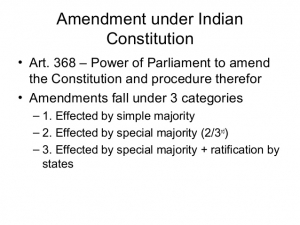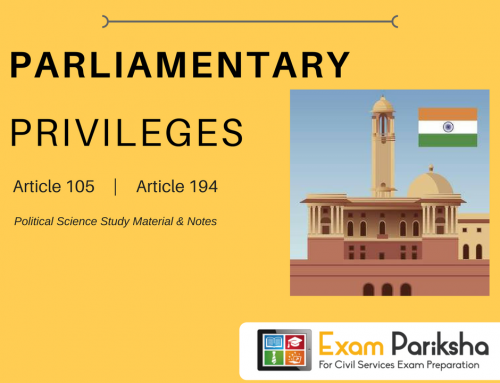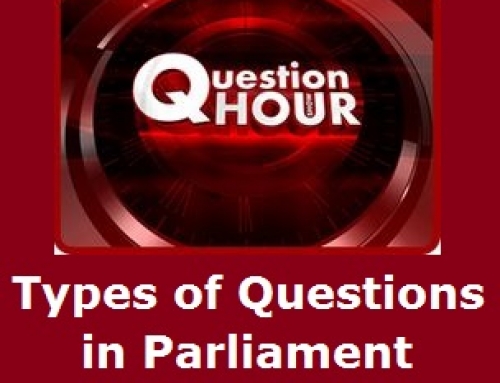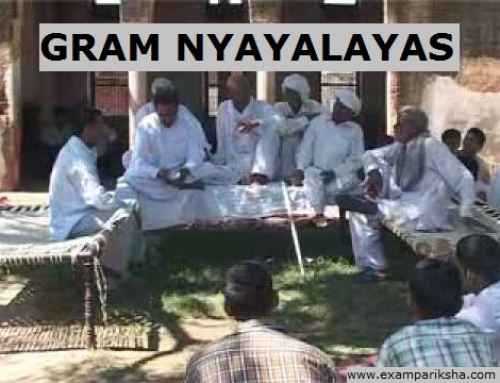Indian constitution is unique in composition. Its salient features have already been discussed here. The procedure of amendment makes the Constitution of India a curious mix of rigid and flexible. This gives flexibility and adaptability to the constitution. Some provisions there can be easily modified and for other parts, special procedures are to be followed.

Highlights of Amendments of Indian Constitution
There are some peculiar aspects of the process of amendment that are worth your attention:
- Despite India being a federal state, the initiative for amending the constitution can only be taken by the Parliament.
- The State Legislatures have no power of amendment initiation.
- The parliament has no power to amend the ‘basic structures of the constitution’.
- The constitution says nothing about disagreements between the two Houses of Parliament with regards to any amendment bill.There is no provision of conducting a Joint Session of both houses in a disagreement scenario.
- It doesn’t require a prior approval from the President.
- Any MP can initiate the amendment bill.
- An amendment bill has to be passed by each house separately since no joint session is prescribed.
- By 24th amendment Act of 1971, The President has to sign an amendment Bill sent to him for approval. There is no provision for him to return the bill.
Article 368: The procedure of amendment of the constitution has been mentioned under Article 368 giving out two methods. One, by Special majority in each house of parliament and other by ratification of half of the states accompanied with special majority of the parliament.
Article 368 also states that Parliament has the right to exercise its constituent power to make “addition, variation or repeal any provision of the Constitution” as per the procedure.
To summarize the above there are three ways in all to amend the constitution:
- In the first category, amendment can be done by the two houses of Parliament simple majority of the members present and voting of before sending it for the President’s assent. The provisions included under this purview are not covered under Article 368. They can be amended by the ordinary law making process and include (a) formation of new states and alteration of areas, boundaries or names of existing ones (b) creation or abolition of Legislative Councils in the states (c) administration and control of scheduled areas and scheduled Tribes (d) the salaries and allowances of the Supreme Court and High Court Judges (e) laws regarding citizenship etc. It is to be noted that the laws passed by Parliament to change the above provisions would not be deemed to be amendments of the Constitution for the purpose of Article 368.
- In the second category amendments require a special majority. Such an amendment can be passed by each House of Parliament by a majority of the total members of that House as well as by the 2/3rd majority of the members present and voting in each house of Parliament and send to the President for his assent which cannot be denied. The provisions included in this include fundamental Rights, Directive Principles of State Policy.
- In the third category besides the special majority mentioned above, the amendment has to be approved also by at least 50% of the State legislatures by a simple majority. This means, for making any changes to the provisions mentioned in Article 368 or modifying an article related to distribution of powers between the Centre and the states, the bill has to be ratified by the legislatures of at least one-half of the states. The provisions requiring this special procedure include- (a) manner of the election of the President, (b) matters relating to the executive power of the union and of the state, (c) representation of the states in Parliament (d) matters relating to the Union Judiciary and High Courts in the states (e) distribution of legislative powers between the union and the states (f) any of the list in the seventh schedule (g) provisions of Article 368 relating to the procedure for amendment of the constitution etc.
Criticism of the amendment procedure:
- No power to initiate amendemnt rests with the state legislatures, they can just pass a resolution requesting parliament to create or abolition provisions of the constitution.
- Major part of the constitution can be changed by the Parliament alone with no say of the state legislature. Also where they have a little say , it just requires asimple majority. Also no time frame is mentioned in the constitution for ratification by states which leaves a lot of uncertainity.
- No provision of joint sitting of both houses in case of a deadlock over the passage of constitutional amendment bill.
- There have been instances of over-reach by the political parties in power for petty short-term gains. For example the – The 24th Amendment in 1971 enabled Parliament to dilute fundamental rights through changes in the Constitution. Also it made obligatory for the President to give his assent to Constitution Amendment Bill when it is presented to him.
- To look into a classic example of how an amendment was brought in only to serve political interest, Where in June 1975 when the Allahabad High Court nullified Prime Minister Indira Gandhi’s election to Parliament. Her government rushed to propose
a Bill amending the Constitution which led to the 39th amendment that placed restrictions on judicial scrutiny over the disputes regarding the election of a Prime Minister. - Such instances urge for a re-look into the powers bestowed upon the Parliament with regards to amendments.





